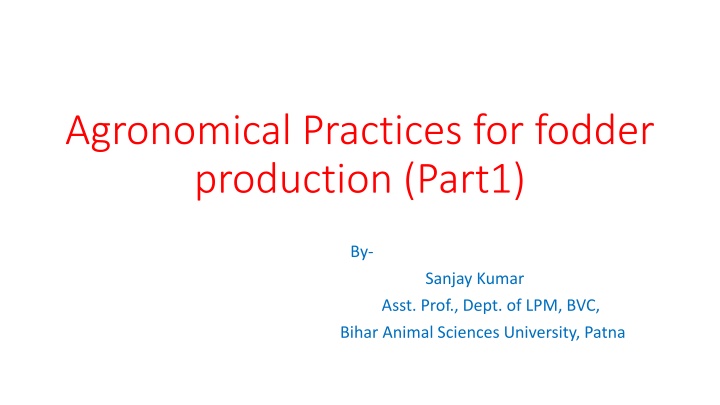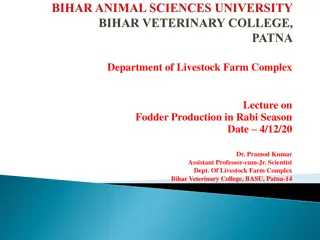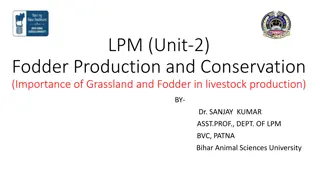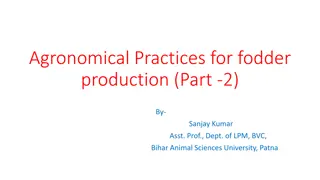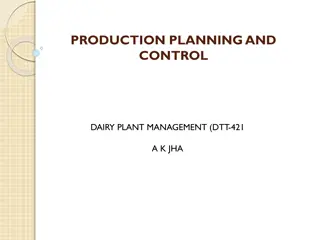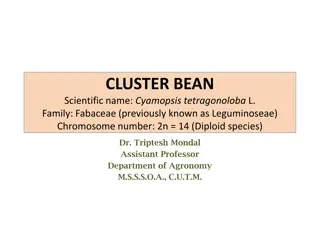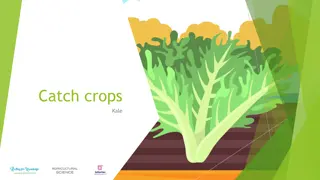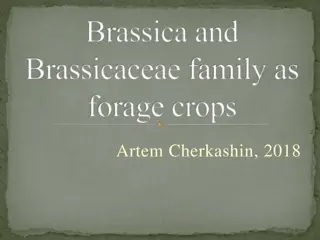Agronomical Practices for Fodder Production - Part 1
Forage crops, fodder crops, and the characteristics of fodder crops are discussed in this informative content. It covers the classification of fodder into different types such as non-leguminous fodders, legumes, pasture grasses and legumes, fodder trees and shrubs, root crops, and miscellaneous fodder plants. The article also delves into the seasonal aspects of fodder production, including Kharif, Rabi, and Zaid seasons.
Download Presentation

Please find below an Image/Link to download the presentation.
The content on the website is provided AS IS for your information and personal use only. It may not be sold, licensed, or shared on other websites without obtaining consent from the author.If you encounter any issues during the download, it is possible that the publisher has removed the file from their server.
You are allowed to download the files provided on this website for personal or commercial use, subject to the condition that they are used lawfully. All files are the property of their respective owners.
The content on the website is provided AS IS for your information and personal use only. It may not be sold, licensed, or shared on other websites without obtaining consent from the author.
E N D
Presentation Transcript
Agronomical Practices for fodder production (Part1) By- Sanjay Kumar Asst. Prof., Dept. of LPM, BVC, Bihar Animal Sciences University, Patna
Forage crops / Fodder crops Forage crops- It refers to the plants used for feeding livestock. It includes wild as well as cultivated plants used for feeding animals. According to definition of forage given by National Academy of Sciences (1971) Forage are aerial plant material, mainly grasses and legumes, containing more than 18%crude fibre on dry matter basis. Fodder crops- It refers to cultivated plants or crops , that are used for animal feeding. eg. Cereals, legumes etc.
Characteristics of fodder crops Fodder crops should have 1. Quick growth and short duration. 2. Profuse foliage and heavy yield of fodder. 3. Good palatability and nutritive value. 4. Adaptability to varying agro-climatic conditions on different soils. 5. Capacity to ratoon and give a continuous supply of fodder. 6. Presistence and resistance to pests and diseases. 7. Seed production ability. 8. Tolerance to stresses like drought, flooding, etc.
Classification of Fodder Fodders can be classified into following 6 types- (1) Non- Leguminous fodders/ Cereals fodder. On the basis of duration/ availability of crop it is further of 2 types- (i) Annual- cereal fodders such as maize, Sorghum, Bajra, Ragi, Oat etc. Annual cultivated grass such as Dinanath grass or Deenbandhu grass. (ii) Perennials- cultivated grasses such as Para grass, Napier grass, Sudan grass, Guinea grass
Cont-- (2) Legumes it is further of 2 types- (i) Annual- eg. Berseem, Sweet clover, Cowpea, Horsegram, Groundnut, Beans, Desmodium etc. (ii) Perennials- Lucerne, Red gram etc. 3. Pasture grasses and Pasture legumes Pasture grasses- eg. Mollases grass, Sewan grass, Sabi grass, Hariali grass etc. Pasture legumes-eg.Carribean, Butterfly pea,Centro etc.
Cont-- 4.Fodder trees and shrubs- Subabul, Khejri tree, Sesbania etc. 5. Root crops- eg. Turnip,Beetroot,Carrot, Potatoes, Sweet potatoes etc. 6. Miscellaneous fodder plants- eg. Azolla, Water hyacinth etc.
On the basis of seasons- 1. Khariff fodders- Fodder grows from July to October. These fodders are shown in June- Jul eg. Maize, jowar, sorghum, bajra, cowpea, guar etc. 2. Rabi fodders - grows from October to March . These fodders are shown in October- November lucerne etc. 3.Zaid season- March to June . eg cowpea, sorghum etc. eg. Oat, Turnip, berseem,
Para grass/ Buffalo grass/ Water grass/ Pani wali ghas ( Brachiaria mutica)
Important fodders 8. Subabul ( Leucaena leucocephala) 9. Sweet potato ( Ipomoea batatas) 10. Water hyacinth ( Eichhornia cressipes) 11. Napier grass ( Pennisetum purpureum) 12. Para grass ( Brachiaria mutica) 13. Napier bajra hybrid grass (cross between napier and bajra) Common Name (Botanical Name) 1. Maize (Zea mays) 2. Sorghum ( Sorghum bicolor)/ (Sorghum vulgare) 3. Bajra (Pennisetum typhoides) 4. Oat (Avena sativa) 5. Berseem (Trifolium alexandrium) 6. Lucerne (Medicago sativa) 7. Cowpea (Vigna unguiculata)
